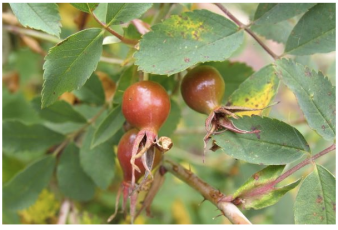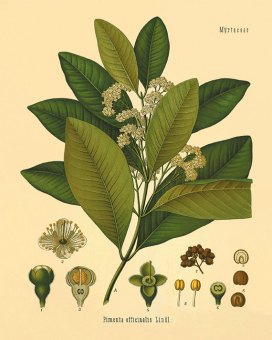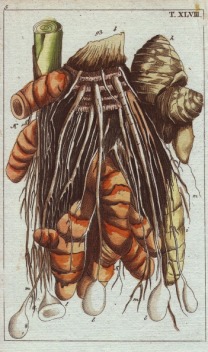In a continuing effort to post about what grows on our farm, here is Part II about more of our spices and herbs. In this entry we will discuss…
PARSLEY • ALLSPICE • CURRY LEAF • BAY LEAF • MORINGA • HIBISCUS • GINGER • TURMERIC • LEMONGRASS • NASTURTIUM • GARLIC GRASS • ROSEHIPS • DANDELION & more …
_______________________________________________________________
GINGER
There are many varieties of ginger growing on Magic Mountain Farm. The roots of one type of ginger can be used to make tea or a ‘broth’ for soups, cooking rice, and making hot cereal. Ginger is known as an anti-inflamatory and tummy soother. Other types of ginger produce yellow and while flowers, with wonderful fragrances.
Awapuhi ginger (pictured, left) was used as soap by ancient Hawaiian people. It is used in commercial cosmetic products today, especially shampoos. Farm visitors enjoy awapuhi for its beauty and have been known to squeeze the ‘bulbs’ in water to release a refreshing, cleansing lather.
______________________________________________________
ROSEHIPS:
Rose hips are the round portion of the rose flower just below the petals. Rose hips contain the seeds of the rose plant. Dried rose hips and the seeds are used together to make medicine.
 Fresh rose hips contain a lot of vitamin C, so they share many uses with vitamin C including preventing and treating colds, flu, and vitamin C deficiencies. However, much of the vitamin C in rose hips is destroyed during drying and processing…
Fresh rose hips contain a lot of vitamin C, so they share many uses with vitamin C including preventing and treating colds, flu, and vitamin C deficiencies. However, much of the vitamin C in rose hips is destroyed during drying and processing…
Rose hips are also used for stomach disorders including stomach spasms, stomach acid deficiency, preventing stomach irritation and ulcers, and as a “stomach tonic” for intestinal diseases. They are also used for diarrhea, constipation, gallstones, gallbladder ailments, lower urinary tract and kidney disorders, fluid retention (dropsy or edema), gout, back and leg pain (sciatica), diabetes, high cholesterol, weight loss, high blood pressure, chest ailments, fever, increasing immune function during exhaustion, increasing blood flow in the limbs, increasing urine flow and quenching thirst.
INFO SOURCE: http://www.webmd.com/vitamins-supplements/ingredientmono-839-rose%20hip.aspx?activeingredientid=839&activeingredientname=rose%20hip
ALLSPICE LEAVES:
Seeds must be harvested before they reach full maturity. On our farm we mostly use the leaves. They can be dried or added fresh to dishes. The oil from allspice seeds is used for toothaches and as a digestive aide. Fresh leaves are good for seasoning hot cider and some soups.
INFO SOURCE:
Dandelions:
Dandelions (Taraxacum officinale) are the scourge of many a lawn perfectionist, and everyone who ever had a front yard will recognize the barbed leaves and cherubic yellow flowers. But don’t wipe them out with herbicides, just eat them! Dandelion leaves are a perfect, gourmet salad green when tossed with a light vinaigrette, and are packed with vitamin A, vitamin C, and beta carotene.
INFO SOURCE:
http://www.goodhousekeeping.com/home/gardening/weeds-edible-plants-0409#slide-2

PARSLEY:
Parsley has been used as a source of certain vitamins and minerals. Parsley seed was used traditionally as a carminative to decrease flatulence and colic pain. The root was used as a diuretic and the juice to treat kidney ailments. Parsley oil also has been used to regulate menstrual flow in the treatment of amenorrhea and dysmenorrhea, and is purported to be an abortive. Bruised leaves have been used to treat tumors, insect bites, lice, skin parasites, and contusions. At one time, parsley tea was used to treat dysentery and gallstones. Other reported traditional uses include treatment of diseases of the prostate, liver, and spleen. Historically, parsley also has been used in the treatment of anemia, arthritis, and cancers, as an expectorant, antimicrobial, aphrodisiac, hypotensive, diuretic, and laxative.

• In Egypt and Sudan, hibiscus is used to help maintain a normal body temperature, support heart health, and encourage fluid balance.*
• North Africans have used hibiscus internally for supporting upper respiratory health including the throat throat and also use it topically to support skin health
• In Europe, hibiscus has been employed to support upper respiratory health, alleviate occasional constipation, and promote proper circulation.* It is commonly used in combination with lemon balm and St John’s Wort for restlessness and occasional difficulty falling asleep.*
• Hibiscus is traditionally used for supporting normal blood pressure maintenance in Iran — a use that has been validated in several recent studies.†
INFO SOURCE:
http://www.gaiaherbs.com/articles/detail/42/The-Surprising-Health-Benefits-of-Hibiscus
MORNINGA TREE:
Popular in the Philippines, the leaves and seed pods of this amazing tree are edible, and healthful. Raw, the leaves have a lemony, peppery flavor. Cooked, they taste similar to spinach. Click on the links below to learn more.

These sunny, wonderful little flowers originated in South America and were widely used by the Meso-Americans for urinary tract infections, kidney problems and for their general antibiotic action.
The leaves were used to prevent scurvy and to supplement the daily diet and add flavor. The peppery leaves were very popular and the seeds were a prized delicacy.
INFO SOURCE:
http://fionajeanmckay.hubpages.com/hub/The-Various-Health-Benefits-and-Uses-of-Nasturtiums
CURRY LEAF:
Curry leaves are natural flav

ouring agents with a number of important health benefits, which makes your food both healthy and tasty along with pleasing aroma. They contain various antioxidant properties and have the ability to control diarrhea, gastrointestinal problems such as indigestion, excessive acid secretion, peptic ulcers, dysentery, diabetes and an unhealthy cholesterol balance. They are also believed to have cancer fighting properties and are known to help protect the liver.
INFO SOURCE:
BAY LEAVES:
- Enzymes that break down proteins and promote healthy digestion
- Phytonutrients that help improve heart function
- Compounds believed to aid in cancer prevention
And for those seeking to treat diabetes, the antioxidants provided by bay leaves aid in the absorption of insulin, which can have a powerful overall health effect.
INFO SOURCE:
Plantain:
Although this plant may not count as a spice or an herb, I am including it here because it is loaded with vitamins and minerals and also, it tastes good.
Plantain (Plantago major, white man’s foot) is another one of those plants that seems to thrive right on the edge of gardens and driveways, but it’s also edible. Pick the green, rippled leaves and leave the tall flower stems. Blanch the leaves and sauté with some butter and garlic just as you would with kale or any other tough green.
INFO SOURCE:
http://www.goodhousekeeping.com/home/gardening/weeds-edible-plants-0409#slide-4

GARLIC GRASS:
Garlic grass (Allium vineale or wild garlic) is an herbal treat often found lurking in fields, pastures, forests and disturbed soil. It resembles cultivated garlic or spring onions, but the shoots are often very thin. Use it in sandwiches, salads, SOUP, pesto or chopped on main courses like scallions.
INFO SOURCE:
http://www.goodhousekeeping.com/home/gardening/weeds-edible-plants-0409#slide-5
TURMERIC:
Turmeric (Curcuma longa), the bright yellow of the spice rainbow, is a powerful medicine that has long been used in the Chinese an d Indian systems of medicine as an anti-inflammatory agent to treat a wide variety of conditions, including flatulence, jaundice, menstrual difficulties, bloody urine, hemorrhage, toothache, …
d Indian systems of medicine as an anti-inflammatory agent to treat a wide variety of conditions, including flatulence, jaundice, menstrual difficulties, bloody urine, hemorrhage, toothache, …
LEMON GRASS:
… Drinking lemongrass tea or eating foods prepared with the herb promotes digestion and provides relief from flatulence. It also helps the body eliminate toxic substances including cleansing of the kidney, pancreas, liver and bladder.
… Lemongrass has natural antimicrobial properties, helping the body fight off bacterial, fungal and viral infections. As an antipyretic, lemongrass helps reduce fevers from colds and flu. That’s how lemongrass also became known as fever grass. …
New research has found even more impressive benefits from the plant. Perhaps most exciting to date is a report from researchers at Ben Gurion University in Israel who discovered during in vitro testing that the compound citral found in lemongrass actually causes cancer cells to self destruct – without harming healthy cells – at a concentration equivalent to a cup of lemongrass tea. …
INFO SOURCE:
 Fresh rose hips contain a lot of vitamin C, so they share many uses with vitamin C including preventing and treating colds, flu, and vitamin C deficiencies. However, much of the vitamin C in rose hips is destroyed during drying and processing…
Fresh rose hips contain a lot of vitamin C, so they share many uses with vitamin C including preventing and treating colds, flu, and vitamin C deficiencies. However, much of the vitamin C in rose hips is destroyed during drying and processing… ouring agents with a number of important health benefits, which makes your food both healthy and tasty along with pleasing aroma. They contain various antioxidant properties and have the ability to control diarrhea, gastrointestinal problems such as indigestion, excessive acid secretion, peptic ulcers, dysentery, diabetes and an unhealthy cholesterol balance. They are also believed to have cancer fighting properties and are known to help protect the liver.
ouring agents with a number of important health benefits, which makes your food both healthy and tasty along with pleasing aroma. They contain various antioxidant properties and have the ability to control diarrhea, gastrointestinal problems such as indigestion, excessive acid secretion, peptic ulcers, dysentery, diabetes and an unhealthy cholesterol balance. They are also believed to have cancer fighting properties and are known to help protect the liver.










Thank you . This was just what I needed to read today . It’s medicine to the spirit just to know where we are . Love to all .
By: Vanya seiss. on March 25, 2015
at 11:29 pm